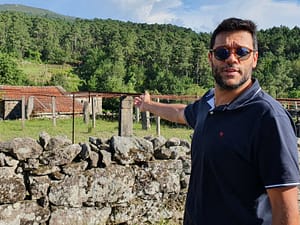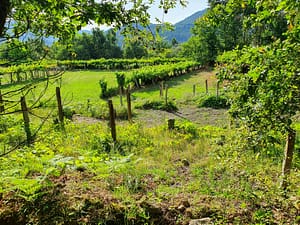After the Simplesmente… Vinho fair I visited some producers in the Vinho Verde region, according to a schedule made by festival general João Roseira. On Tuesday following the fair I was in the northern subregion of Vinho Verde, called Monção e Melgaço. Constantino Ramos was one of the greatest revelations on the whole trip, making superb, stylish, natural white and red wines. Valados de Melgaço does not make fully organic wines, and some with cultured yeasts, but is also very much of interest.
Constantino Ramos
Constantino Ramos was born in Vouzela (Dão-Lafões). After his education in pharmaceutical sciences in Coimbra he went back to the countryside, and after a few harvests in nearby Dão and Douro and one at De Martino in Chile, he came to Melgaço in 2013 to work with Anselmo Mendes, one of the great personalities of the alvarinho world.
In 2015 came the opportunity to work a small vineyard over 70 years old, in Vale do Mouro. He started to make Zafirah, a red wine made with minimal intervention. I put it in the category of great, low-extraction, saline wines with a clear Atlantic touch that you can find from lower Galicia (Rías Baixas and Ribeiro) to the northern coast of Portugal. Remember, the Rías Baixas subregion of Condado do Tea begins just over the nearest bridge, and the historically important Ribeiro is also very close. These regions share grape varieties, and soil and climate are also similar. So if you think of red Vinho Verde as dark and meaty, maybe somewhat spritzy (and made by the vinhão variety), you have by now understood that this one is different.
-Old vines is not a common concept in Vinho Verde country, says Constantino. Nevertheless, currently he is in the process of recovering old vineyards, again in his words, -to give more credit to the reds from Monção and Melgaço, which were in the past very famous and compared to the wines from Burgundy and the Bordeaux clarets.
What about alvarinho, the emblematic and “inevitable” grape of the subregion? He continues: -Of course because I was working with Anselmo Mendes [Mr. Alvarinho] it was difficult to resist also producing an alvarinho wine. But it had to be something that could clearly show my vision of the variety in this specific terroir. So, using a small vineyard planted at about 250m high, I created Afluente. The name means tributary, metaphorically something that leads to, something that pushed me a step further.
Constantino has since long had his personal projects, his own wines and wineries for whom he consults, in addition to his “day job” at Anselmo Mendes. In January this year he took the chance to dedicate all his time to his personal projects. Of his own wines he makes 8.000 bottles annually, but he wants to increase a little.
We arrive in Riba do Mouro, a high altitude hamlet belonging to Monção. It has a cooler climate than the rest of the subregion. Here in Vale do Mouro was formerly a glacier, and therefore there is a great complexity of soils, granite, quartz, feldspar etc. The topsoil is only 40 cm down to the mother rock. Constantino says he prefer not to buy fields: -As I want to give something back to the people I prefer to work with the people. It’s something of an ethnographic project, driven by passion. -I have always been fond of reading. It helps you understand, gives you context.
Constantino has always worked organic. -Even the old viticulturists have a habit only to spray with copper, he says.
After a visit to the most important vineyards we appropriately enjoyed his wines in a local context, a meal of bacalhau and partridge in the Tiro no Prato restaurant near Viana do Castelo, where Constantino lives. The Afluente 2020, an alvarinho fermented and aged in used barrels, was perfect with the bacalhau with onion, garlic, black olives, flat potatoes and olive oil. The wine had a pale yellow colour; an aroma of apple, citrus, wet stone more mineral than perfumed, actually; glyceric in the mouth, energetic, and with a superb integrated acidity.
Zafirah 2021 is a field-blend from five plots of more than 50 year old vines on granite, with varieties like brancelho, borraçal (caíño), espadeiro, vinhão and pedral. It was skin-macerated one day before alcoholic fermentation, then light filtering and a bit sulphur added. It clocks in at 10.5% alcohol. Red cherry colour; red and wild berries (raspberry, blackberry); fresh in the mouth, saline. Like the white wine it went well with the bacalhau, and was a perfect pairing to partridge with a rich rice.
Juca 2021 is a tribute to his wife’s grandfather, who has helped Constantino a lot. It originates in the centennial vineyard of vinhão, brancelho a.o. The skins are soaked in steel and it’s carefully pumped over. The alcohol is 10%. Dark blackish blue, slightly carbonic; dark fruits (blackberry, blueberry), some licorice; it’s juicy, not especially tannic, with a fruitiness all the way. We can maybe look upon it as a luxury version of the dark Vinho Verde style.
Valados de Melgaço
Artur Meleiro picked me up in the Sousa subregion, and as I still hadn’t received my luggage after arriving in Porto three days ago he kindly offered me a shopping trip to Braga city. Then we continued north, had lunch in a Melgaço roadside restaurant, before we finally arrived at Quinta de Golães. Then after some vineyard sightseeing we arrived at the winery by the bridge bordering Spain.
Artur himself was born in Melgaço, one of the two villages that give name to the sub-region. He moved back from Lisboa in 2016 to concentrate fully on this project, after having also lived in Braga and Porto. The family vineyards count on 4 hectares (3,5 hectares alvarinho, the rest trajadura, loureiro and red varieties) Today the production is 30.000 bottles, while the ideal for the future he says is 50.000.
Monção e Melgaço is warmer than the rest of the region during the day and colder in the night, he says. Because of the mountain ranges it’s leaning more to a continental climate. .
Valados de Melgaço is Artur’s project, associated with his cousin Pedro Kock. It encompasses Quinta de Golães, so today they offer two ranges, with those two names respectively.
For the white wines the grape is almost exclusively alvarinho. 60% is in fact purchased, in addition to the grapes from the family vineyards. But the bought-in grapes come from farmers who share the same philosophy, soils/altitude etc. Artur tells, with this traditional viticulture one has to use pesticides. A neutral cultivated yeast is also used (except for the reds).
The aim is to produce elegant and balanced wines, that is faithful to the alvarinho variety and the Monção and Melgaço terroir. I can say that I liked the Golães red and white, as simple and fruity everyday wines. The Valados range was true to what we think of as terroir. I chose three of these wines here.
Valados de Melgaço Reserva 2019 had a few months on the lees with batonnage during a short while. Light yellow colour; expressive concentrate aroma, yellow apples, some anise; quite full and structured in the mouth, with a slightly bitter grapefruity aftertaste. Valados de Melgaço Grande Reserva 2016 is a truly serious wine, but though it was three years older and even more concentrated it was lighter in colour than the reserva. It aged on lees in inox during 46 months, with batonnage in the first 12. Fresh fruit, yellow apples, melon, some balsamic notes; supple concentration and a long finish and good citrussy acidity all the way. Should I pick one favourite it would still be the Valados de Melgaço Natura (Vinificação Tradicional) 2019, a wine made with less sulphur, and nothing added until the end of fermentation. It had 8 months ageing on lees in steel, with batonnage. Yellow colour; aroma of pear, flowers, fennel and a touch of clementine peel; juicy and grapey in the mouth, good, integrated acidity.
2 Comments





























































